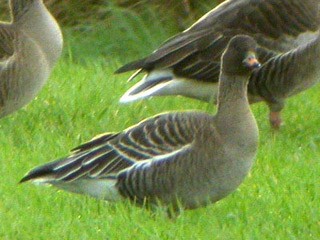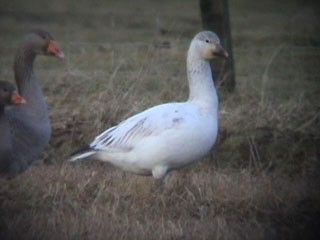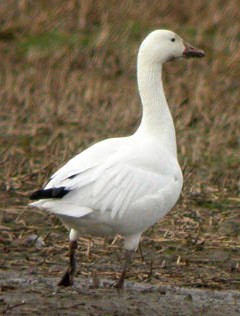 |
| Pink-footed Geese: Redmires, S. Yorks. Overland movement can be spectacular. (Photo: Richard Hill) |
The spectacle of a flock of wild geese passing overhead is one that few observers could fail to marvel at. In Britain and Ireland we're lucky in that large numbers of wintering geese frequent our coastlines from as far away as Siberia in the east and Arctic Canada in the west. These long-distance migrants can, of course, carry vagrants but can also comprise birds of different races in their ranks providing identification challenges and learning curves for those keen to push the boundaries of identification that little bit further.
Taiga Bean Goose Anser fabalis fabalis
The taxonomy of bean geese is presently in a state of flux. Some authors split Taiga and Tundra Bean Goose, whilst others lump them under Bean Goose. In Europe, the main breeding area of Taiga Bean Goose is in the taiga zone of northern Fennoscandia and western Russia, eastwards. The main wintering grounds are in southern Sweden, countries along the southern part of the Baltic and the Low Countries and is thought to number 80,000 birds, 30,000 of which are in southern Sweden. There has been an increase in the population of Taiga Bean Geese since the 1960s, but it is unclear why this has occurred.
In Britain there are two wintering populations of Taiga Bean Geese, totalling perhaps 450 birds in most winters. In Norfolk birds can be found in the Yare Valley between late November and mid-February, with up to 100 at Cantley Marshes RSPB TG3803. In Scotland up to 240 birds can be found roosting at Fannyside Lochs (Clyde) this winter NS819722, or feeding at Slamannan (Forth) NS835765 or NS831768. Away from these sites, Taiga Bean Goose is a truly rare bird.
 |
 |
| Taiga Bean Goose: Slamannan, Forth (Nov 2002). An extremely rare bird away from the winter flocks in Scotland and Norfolk. (Photo: John Molloy) | Taiga Bean Goose: Denge Marsh, Kent (Feb 2003). Larger than Tundra Bean Geese, with a slimmer neck, and longer, mostly orange, bill. (Photo: Marcus Lawson) |
 |
 |
| Taiga Bean Goose: Martin Mere, Lancs (Mar 2003). The lower mandible is distinctly narrow and flat. (Photo: Mark Breaks) | Taiga Bean Goose: Martin Mere, Lancs (Mar 2003). Taiga is a large goose, noticeably so compared with Pink-footed Geese. (Photo: Mark Breaks) |
Tundra Bean Goose Anser fabalis serrirostris
Formerly a winter vagrant, is now an increasingly regular winter visitor but is still something of a scarcity, particularly away from East Anglia. In most winters small groups are usually detected with other grey geese flocks, but cold-weather influxes produce the largest numbers and result from displacement of birds from the main wintering grounds on the near-continent (the European wintering population numbers around 300,000 birds). During such influxes 3-figure flocks have been noted, but in most winters single-figure counts are the norm. A rough rule-of-thumb for east and southeast Britain suggests that most bean geese reported away from the main Taiga Bean Geese wintering areas turn out to be Tundras, but, of course, exceptions to the rule do occur and further north the rule-of-thumb perhaps favours Taiga. Birds of both Taiga and Tundra forms can sometimes have the orange on the bare parts coloured pink — these birds are referred to as 'Sushkin's Goose'.
 |
 |
| Tundra Bean Goose: Myroe Levels, Londonderry (Jan 2004). A narrow orange subterminal band on the bill is typical, but this is variable and the extent of orange on the bill is not a definitive identification feature. (Photo: Paul and Andrea Kelly) | Tundra Bean Goose: Dumpton, Kent (Jan 2004). Similar in structure to Pink-footed Goose, with which Tundras can be easily confused — and vice-versa. Tundra is, on average, larger and longer-billed. (Photo: Dylan Wrathall) |
 |
 |
| Tundra Bean Goose: Kilnsea, E. Yorks (Jan 2004). Small winter groups along the east coast more often than not turn out to be Tundras. (Photo: Mark Stirland) | Tundra Bean Goose: Tophill Low, E. Yorks (Nov 2003). Shorter bill with a deeper base to the lower mandible than Taiga. Unlike Pink-footed Geese, the head, flanks and upperparts are dark, the palest part of the bird often being the breast. (Photo: Paul Ashton) |
Pink-footed Goose Anser brachyrhynchus
One of our more familiar wintering geese, with large numbers wintering in north Norfolk, the Humber estuary, eastern Scotland (where three-quarters of our wintering population can be found) and the northwest of England on estuaries such as the Ribble and Solway. Inland birders can often share in the spectacle as movements are often noted over inland counties on a line between The Wash and Northwest, with movement usually noted on clear anticyclonic winter days. The increasing UK wintering population is estimated at 225,000 birds (compared to 30,000 in the 1950s). Our wintering population breeds almost exclusively in central Iceland and eastern Greenland. Another population of Pink-feet breeds in Svalbard and winters in the Low Countries and totals 35,000 birds. These two populations do not mix through the year
 |
 |
| Pink-footed Goose: Fairhaven, Lancs (Feb 2003). Sometimes the bare-parts can be difficult to assess at distance, leading to confusion with Tundra Bean Goose. (Photo: Sue and Andy Tranter) | Pink-footed Goose: Gibraltar Point, Lincs (Jan 2004). Lone birds can make judging size and structure even more difficult. (Photo: Steve Botham) |
 |
 |
| Pink-footed Goose: Burnham Market, Norfolk (Oct 2002). The contrasting paler forewing of Pink-feet (compared with bean geese) is noticeable in flight, as is the broad white trailing edge to the tail. | Pink-footed Goose: Burnham Market, Norfolk (Oct 2002). The head and neck contrast with the greyish-washed upperparts. |
Eurasian White-fronted Goose Anser albifrons albifrons
Nominate pink-billed birds occur at several traditional sites in the south of England, though numbers are declining due to birds taking advantage of milder winters and wintering further east in Europe. As a result, harsh cold winters on the continent produce the largest numbers of birds, but during a winter like the present one numbers are relatively small. Favoured sites include the Severn Estuary (Slimbridge WWT SO723048 where up to 800 have been noted this winter), Norfolk (500 have been recorded at Reedham) and Kent (350 birds have been noted at Capel Fleet TR0169), plus smaller numbers in Suffolk. Other Siberian/North American forms might also be expected to occur
 |
 |
| Eurasian White-fronted Goose: Farmoor, Oxon (Feb 2003). White forehead blaze on adults is restricted to the bill base. (Photo: Nic Hallam) | Eurasian White-fronted Goose: Pingewood, Berks (May 2002). The barred underparts develop during the 1st winter.(Photo: Marek Walford) |
 |
 |
| Eurasian White-fronted Goose: Keyhaven, Hants (Jan 2002). The pink bill is shorter than Greenland White-front. (Photo: Russell Wynn) | Eurasian White-fronted Goose: Keyhaven, Hants (Jan 2002). (Photo: Russell Wynn) |
Greenland White-fronted Goose Anser albifrons flavirostris
As the name suggests, these orange-billed birds breed in western Greenland. This population moves to Iceland before moving to winter in Ireland (10,000 winter at Wexford Slobs (Co. Wexford) and Western Scotland (particularly Islay where 13,000 birds winter), with smaller numbers in Wales and northern Scotland. The total British population is put at 17,000, with 14,000 in Ireland. In England, small numbers winter in the Grindon Lough (Northumberland) area NY806677. These are the only regular birds in England and have been wintering there each winter for over 10 years. Records away from the winter haunts are rare, with, for example, just 20 records in Norfolk, and just over 20 in Yorkshire.
 |
 |
| Greenland White-fronted Goose: Islay, Argyll (Mar 2002). 1st-winters lack the bold belly patches of adults. (Photo: Russell Slack) | Greenland White-fronted Goose: Holkham, Norfolk (Feb 2003). Compared with albifrons (background), darker, with a longer and slimmer orange-toned bill. (Photo: Andrew Easton) |
 |
 |
| Greenland White-fronted Goose: Grindon, Northumbs (Apr 2003). Larger and longer-necked than albifrons, plus darker tailed with only a narrow white border, unlike albifrons which has a noticeable white border. (Photo: John Malloy) | Greenland White-fronted Goose: Holkham, Norfolk (Feb 2003). Compared with albifrons (background), darker, noticeably so on the belly, with more uniform upperparts. (Photo: Andrew Easton) |
Lesser White-fronted Goose Anser erythropus
A rare vagrant to our shores, with the majority of records over the years at Slimbridge WWT (Glos). This species breeds from northern Fennoscandia eastwards to Siberia — the main wintering grounds are from the coastal plains of the Caspian and Black Sea eastwards. There has been a significant decline in numbers in northern Scandinavia (from more than 10,000 birds before 1950 to fewer than 30 pairs by 1990). To try and redress the situation, reintroduction schemes commenced in the area using Barnacle Geese as foster parents. This has led to the regular wintering of Lesser Whitefronts in The Netherlands, which has resulted in some British records (for example, a captive-bred bird released in Lapland in July 1993 consorted with Norfolk Bean Geese between November 1993 and January 1994, being relocated in Denmark between February and April and then back in Finland towards the end of April). However, the status of truly wild birds has been clouded recently with the result that birds away from traditional haunts, such as Slimbridge, are treated with suspicion.
 |
 |
| Lesser White-fronted Goose: Lancs (Jul 2002). This feral bird illustrates the yellow orbital ring to the eye, one of the features to separate this species from White-fronted Goose (some White-fronts can show a narrow orbital ring), as do the less extensive belly markings (the wing-tips also extend beyond the tail). (Photo: Stephen Dunstan) | Lesser White-fronted Goose: Blackpool, Lancs (Jan 2002). Note also that the white on the head extends onto the crown and and the bill is much smaller than that of White-fronted Goose. (Photo: Stephen Dunstan) |
 |
 |
| Lesser White-fronted Goose: Slimbridge, Glos (Feb 2003). What better credentials for a potentially 'wild' bird than a 1st-winter at this location, but neck-collared birds from the reintroduction scheme have also been noted at Slimbridge. (Photo: John Malloy) | Lesser White-fronted Goose: Slimbridge, Glos (Feb 2003). Unlike a White-front of the same age, the nail of the bill is pale and the prominent orbital ring is evident, as would be the smaller size and darker plumage. (Photo: Robert Duckhouse) |
Greylag Goose Anser anser
A familiar goose, with the majority of British birds introduced during the 20th century. This has resulted in a feral breeding population of just under 30,000 pairs. However, there is an increasing breeding population of 1,000 pairs of native birds breeding in northwest Scotland. During the winter around 80,000 wild birds from Iceland arrive to winter in Northern Ireland and Scotland, with ringing studies illustrating that these birds can penetrate as far south as northern England and Norfolk. Scandinavian birds winter in The Netherlands, France and Spain and there have been ringing recoveries in Britain from Poland, and neck-collared birds from Norway and Sweden have been seen in southeast England.
Pink-billed birds of the eastern race rubrirostris (Eastern Greylag Goose) have been noted as an occasional vagrant to Europe and there have been a small number of birds considered to be this race identified in Britain.
 |
 |
| Greylag Goose: Martin Mere, Lancs (Oct 2003). Large size with large head and heavy bill — juveniles are much as adults but lack the indistinct belly spots. (Photo: Sue and Andy Tranter) | Greylag Goose: Martin Mere, Lancs (Oct 2003). The forewing is exceptionally pale, noticeable even on birds head-on. (Photo: Sue and Andy Tranter) |
 |
 |
| Greylag Goose: Martin Mere, Lancs (Oct 2003). The two-toned underwing is diagnostic. (Photo: Sue and Andy Tranter) | Greylag Goose: Martin Mere, Lancs (Apr 2003). Note the thick neck and pale head. (Photo: Sue and Andy Tranter) |
Snow Goose Anser caerulescens
Comprises two subspecies, both of which have occurred in Europe. The nominate race, known as 'Lesser Snow Goose' caerulescens breeds over most of range and is smaller and slimmer than the heavier-billed 'Greater Snow Goose' atlanticus from northwest Greenland and islands in the north of Baffin Bay. Blue-phase birds occur commonly in nominate birds but very rarely in atlanticus. Nominate-race birds winter mainly along the Gulf coast of the USA and atlanticus along the Atlantic coast between Maryland and North Carolina.
In Britain there is a feral breeding population of perhaps up to 100 pairs, with a feral flock on the Inner Hebrides and other smaller feral flocks in Norfolk and Hampshire. Birds considered to be genuine migrants do occur, and are usually considered to be those occurring with carrier flocks of Greenland White-fronted Geese in northwest Scotland and Ireland.
 |
 |
| Lesser Snow Goose: Islay, Argyll (Mar 2002). Blue morphs have head, upper neck and tail tip white, bill and legs are pink (Photo: Russell Slack) | Lesser Snow Goose: Islay, Argyll (Mar 2002). Blue morphs have obvious white fringes to the elongated tertials. (Photo: Russell Slack) |
 |
 |
| Greater Snow Goose: N. Uist, Outer Hebrides (Dec 2003). A 1st-winter with wild Greylag Geese has some of the best credentials for a wild bird. (Photo: Martin Scott) | Greater Snow Goose: N. Uist, Outer Hebrides (Dec 2003). 1st-winters are variably mottled, with greyish crown and neck and duller bare parts — adult plumage is attained through the winter. (Photo: Martin Scott) |
 |
 |
| Greater Snow Goose: Martin Mere, Lancs (Nov 2002). A feature of Snow Goose is the black 'grinning patch' along the cutting edge of the bill. (Photo: Sue and Andy Tranter) | Greater Snow Goose: North Slob, Co. Wexford (Jan 2004). Rusty stains on the head and neck are frequent within the natural range and might be a good pointer towards a genuine vagrant. (Photo: Paul and Andrea Kelly) |
Ross's Goose Anser rossii
Breeds on the tundra of the Northwest Territories of Canada, and winters mainly in California with smaller numbers along the Gulf coastline. Wintering birds were formerly rare on the Atlantic coast, but are increasing. Within the range, formerly a rare species, the population has increased considerably since the 1960s.
As this species is commonly kept in captivity the origin of individuals is always difficult to ascertain. A known pair of escapes from Britain attempted to breed in Iceland and returned with wild geese to Scotland. Recent sightings with wild geese in Norfolk and Scotland are considered by many to relate to wild birds, as are some earlier records of birds with wild geese.
 |
 |
| Ross's Goose: Pennington, Gtr Manchester (Oct 2001). This feral bird illustrates the smaller bill, lacking the 'grinning patch' of Snow Goose. (Photo: Sue and Andy Tranter) | Ross's Goose: Wighton, Norfolk (Nov 2001). The grey wash on the hindneck and scapulars indicates a 1st-winter bird. (Photo: Paul Hackett) |
 |
 |
| Ross's Goose: Caerlaverock, Dumfries and Galloway (Dec 2002). The small size of this species is evident in comparison with other small geese, such as Barnacle Geese. (Photo: Paul Bowerman) | Ross's Goose: Caerlaverock, Dumfries and Galloway (Nov 2002). (Photo: John Molloy) |
(A list of references will be added at the end of Part Two of the 'Winter Geese' article, which deals with 'Branta' geese.)








